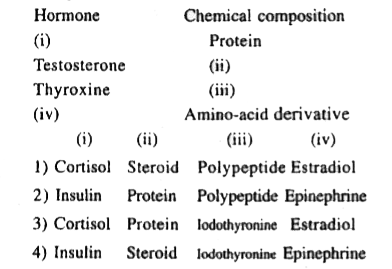How do various hormones interact, synergically and antigonistically ?
Step-by-Step Solution
1. Understanding Hormonal Interaction:
- Hormones can interact in two primary ways: synergistically and antagonistically.
- Synergistic Interaction: This occurs when two or more hormones work together to produce a combined effect that is greater than the sum of their individual effects.
- Antagonistic Interaction: This occurs when hormones oppose each other's actions, effectively reversing or negating their effects.
2. Example of Synergistic Interaction:
- A classic example of synergistic interaction is the collaboration between Luteinizing Hormone (LH) and Follicle Stimulating Hormone (FSH) in males.
- Both hormones are essential for normal sperm production. If either hormone is absent, normal sperm production cannot occur, demonstrating how their combined action is necessary for a specific physiological outcome.
3. Example of Antagonistic Interaction:
- A well-known example of antagonistic interaction is seen in the regulation of blood glucose levels by insulin and glucagon.
- Insulin: Produced by the beta cells of the islets of Langerhans in the pancreas, insulin lowers blood glucose levels by promoting the uptake of glucose by cells and converting it into glycogen in the liver.
- Glucagon: Produced by the alpha cells of the islets of Langerhans, glucagon raises blood glucose levels by stimulating the liver to convert glycogen back into glucose and release it into the bloodstream.
- When blood glucose levels rise, insulin is secreted to lower them. Conversely, when blood glucose levels drop, glucagon is secreted to raise them. This interplay illustrates how these hormones work antagonistically to maintain homeostasis.
4. Feedback Mechanisms:
- Both interactions are regulated by feedback mechanisms. In the case of insulin and glucagon, negative feedback loops ensure that hormone levels adjust according to the body’s needs, maintaining balance in glucose levels.
- Hormones can interact in two primary ways: synergistically and antagonistically.
- Synergistic Interaction: This occurs when two or more hormones work together to produce a combined effect that is greater than the sum of their individual effects.
- Antagonistic Interaction: This occurs when hormones oppose each other's actions, effectively reversing or negating their effects.
- A classic example of synergistic interaction is the collaboration between Luteinizing Hormone (LH) and Follicle Stimulating Hormone (FSH) in males.
- Both hormones are essential for normal sperm production. If either hormone is absent, normal sperm production cannot occur, demonstrating how their combined action is necessary for a specific physiological outcome.
- A well-known example of antagonistic interaction is seen in the regulation of blood glucose levels by insulin and glucagon.
- Insulin: Produced by the beta cells of the islets of Langerhans in the pancreas, insulin lowers blood glucose levels by promoting the uptake of glucose by cells and converting it into glycogen in the liver.
- Glucagon: Produced by the alpha cells of the islets of Langerhans, glucagon raises blood glucose levels by stimulating the liver to convert glycogen back into glucose and release it into the bloodstream.
- When blood glucose levels rise, insulin is secreted to lower them. Conversely, when blood glucose levels drop, glucagon is secreted to raise them. This interplay illustrates how these hormones work antagonistically to maintain homeostasis.
- Both interactions are regulated by feedback mechanisms. In the case of insulin and glucagon, negative feedback loops ensure that hormone levels adjust according to the body’s needs, maintaining balance in glucose levels.
Topper's Solved these Questions
- PLANT GROWTH AND DEVELOPMENTBOOK - ICSECHAPTER - PLANT GROWTH AND DEVELOPMENTEXERCISE - TEST YOUR PROGRESS (OBJECTIVE TYPE QUESTIONS)
92 Videos
- PLANT GROWTH AND DEVELOPMENTBOOK - ICSECHAPTER - PLANT GROWTH AND DEVELOPMENTEXERCISE - TEST YOUR PROGRESS (FILL IN THE BLANKS WITH APPROPRIATE WORDS)
27 Videos
- PLANT GROWTH AND DEVELOPMENTBOOK - ICSECHAPTER - PLANT GROWTH AND DEVELOPMENTEXERCISE - REVIEW QUESTIONS (SHORT ANSWER TYPE QUESTIONS)
13 Videos
- PHOTOSYNTHESIS IN HIGHER PLANTS BOOK - ICSECHAPTER - PHOTOSYNTHESIS IN HIGHER PLANTS EXERCISE - REVIEW QUESTIONS (QUESTION BASED ON EXPERIMENTS)
7 Videos
- PLANT KINGDOM BOOK - ICSECHAPTER - PLANT KINGDOM EXERCISE - REVIEW QUESTIONS (LONG ANSWER TYPE QUESTIONS)
12 Videos
Similar Questions
Knowledge Check
The given table enlists various hormones and their chemical nature. Select the option which completes the table
 A(i)(ii)(iii)(iv)CortisolSteroidPolypeptideEstradiolB(i)(ii)(iii)(iv)OxytocinProteinlodothyronineEpinephrineC(i)(ii)(iii)(iv)CortisolProteinAmineEstradiolD(i)(ii)(iii)(iv)OxytocinSteroidlodothyronineEpinephrine
A(i)(ii)(iii)(iv)CortisolSteroidPolypeptideEstradiolB(i)(ii)(iii)(iv)OxytocinProteinlodothyronineEpinephrineC(i)(ii)(iii)(iv)CortisolProteinAmineEstradiolD(i)(ii)(iii)(iv)OxytocinSteroidlodothyronineEpinephrine
How do we produce sound ?
View SolutionThe given table enlistes various hormones and their chemical nature.Select the option which completes tha table.

View SolutionLipid soluble hormone works by interacting with
View SolutionAn orchid plant is growing on the branch of mango tree. How do you describe the interaction between orchid and mango tree?
View SolutionHow do autoimmune diseases result?
View SolutionHow do cells increase in number?
View SolutionHow do the various leaf modifications help plants?
View Solution
